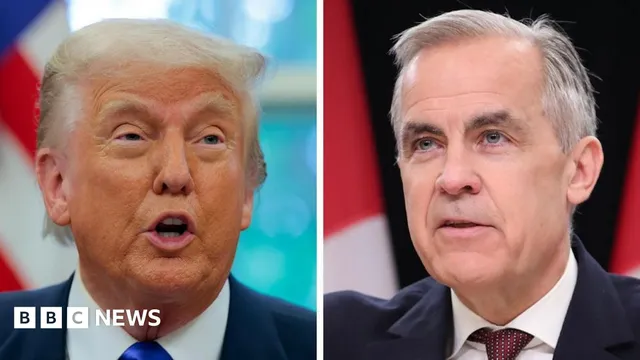
Mark Carney confronts Trump amid rising trade tensions
2025-05-06 13:10- Canadian Prime Minister Mark Carney announced his visit to meet U.S. President Donald Trump amid escalating trade tensions.
- Carney's election victory reflects public discontent with Trump's trade policies and a desire for stronger Canadian sovereignty.
- The upcoming meeting aims to address immediate tariff issues and restore a cooperative yet assertive relationship between Canada and the United States.
Express your sentiment!
Insights
In early May 2025, Canadian Prime Minister Mark Carney announced his upcoming visit to Washington, D.C., for a critical meeting with U.S. President Donald Trump. This visit, scheduled for Tuesday, marks the first face-to-face dialogue between the two leaders since Carney's election on a platform designed to oppose Trump's policies. The discussions are expected to focus on trade and security, as tensions between the two neighbors have escalated due to Trump's ongoing trade war and threats toward Canadian sovereignty. Carney's recent election victory is interpreted as a direct response to Trump's aggressive stance, as Canadians voted for a leadership that would assert their nation's interests against American pressure. During his campaign earlier in the year, Carney emphasized the importance of standing up to Trump and securing the best deal for Canada, signaling a shift in diplomatic relations following years of strained interactions between the two countries. This meeting is particularly significant as it occurs against the backdrop of new tariffs imposed by the U.S. that have hurt the Canadian economy, leading to a brewing backlash among Canadian voters against Trump's economic policies. Carney's government argues that Canada has alternatives for trade partnerships beyond the United States. As expected, Carney's government aims to address immediate concerns regarding tariffs while also seeking to rebuild broader relations with the U.S. Carney has articulated a vision of a cooperative but assertive Canada, poised to defend its economic interests while navigating a challenging landscape characterized by Trump's unpredictable approach. The stakes are high as both nations anticipate outcomes that could either alleviate or exacerbate current tensions. The meeting's outcome is seen as crucial not only for Canada but also for the future of U.S.-Canada relations, which have historically been strong but are now under duress. Observers note that Carney's ability to negotiate effectively will be tested as he champions Canadian sovereignty in the face of U.S. pressures. As leaders from both nations prepare for what is expected to be a contentious yet crucial discussion, Carney has expressed a commitment to advocating for Canadian interests and navigating the complexities of trade that have increasingly come to define U.S.-Canada discourse. Overall, the meeting embodies the larger conflict between American trade practices and Canadian national interests, representing a critical moment for the two neighboring countries.
Contexts
The trade relationship between Canada and the United States has been one of the most significant bilateral relationships in the world, primarily because of their geographical proximity and integrated economies. This relationship has evolved over numerous years, significantly shaped by various trade agreements and political decisions. Following World War II, trade between the two nations began to flourish, and the establishment of the General Agreement on Tariffs and Trade (GATT) in 1947 set the stage for more structured trade negotiations. The Canada-US Auto Pact of 1965 served as a landmark agreement, drastically increasing automotive trade and forming the basis for greater economic interdependence. Over time, efforts were made to reduce tariffs and barriers, culminating in the signing of the Canada-US Free Trade Agreement in 1988, which further opened the markets for both countries. In 1994, the trade relationship was expanded with the implementation of the North American Free Trade Agreement (NAFTA), which included Mexico. This trilateral agreement not only eliminated a substantial amount of tariffs on goods but also established protocols for labor and environmental standards. NAFTA brought significant benefits, such as increased trade volumes and investment flows between Canada and the US, which subsequently enhanced job creation and economic growth. However, ongoing debates surrounding trade deficits and job losses in specific sectors led to scrutiny and calls for renegotiation of the agreement, reflecting the need for adaptation in a changing global environment. In 2018, these tensions culminated in the renegotiation of NAFTA, resulting in the United States-Mexico-Canada Agreement (USMCA), known as CUSMA in Canada. This new agreement addressed contemporary issues such as digital trade, intellectual property rights, and labor standards. It retained many of the provisions of NAFTA while implementing new standards aimed at promoting fairer trade practices. Importantly, CUSMA sought to balance the interests of all three nations in the face of growing economic challenges posed by global competition and domestic political pressures. Canada's response to these changes has been strategic, emphasizing the importance of maintaining strong trade ties with the US while also diversifying its trade partnerships globally. Today, Canada and the United States remain each other's largest trading partners, with deep integration across multiple sectors including agriculture, natural resources, manufacturing, and services. This interconnectedness is vital not only for economic prosperity in both countries but also for the stability of the broader North American region. Future trade relations will likely continue to evolve in response to global economic trends, domestic needs, and geopolitical influences, necessitating ongoing collaboration and dialogue. As both nations navigate these challenges, the need for a robust and flexible trade framework will be key to sustainable economic growth and mutual benefit.